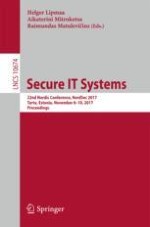2017 | Buch
Secure IT Systems
22nd Nordic Conference, NordSec 2017, Tartu, Estonia, November 8–10, 2017, Proceedings
herausgegeben von: Helger Lipmaa, Aikaterini Mitrokotsa, Raimundas Matulevičius
Verlag: Springer International Publishing
Buchreihe : Lecture Notes in Computer Science
